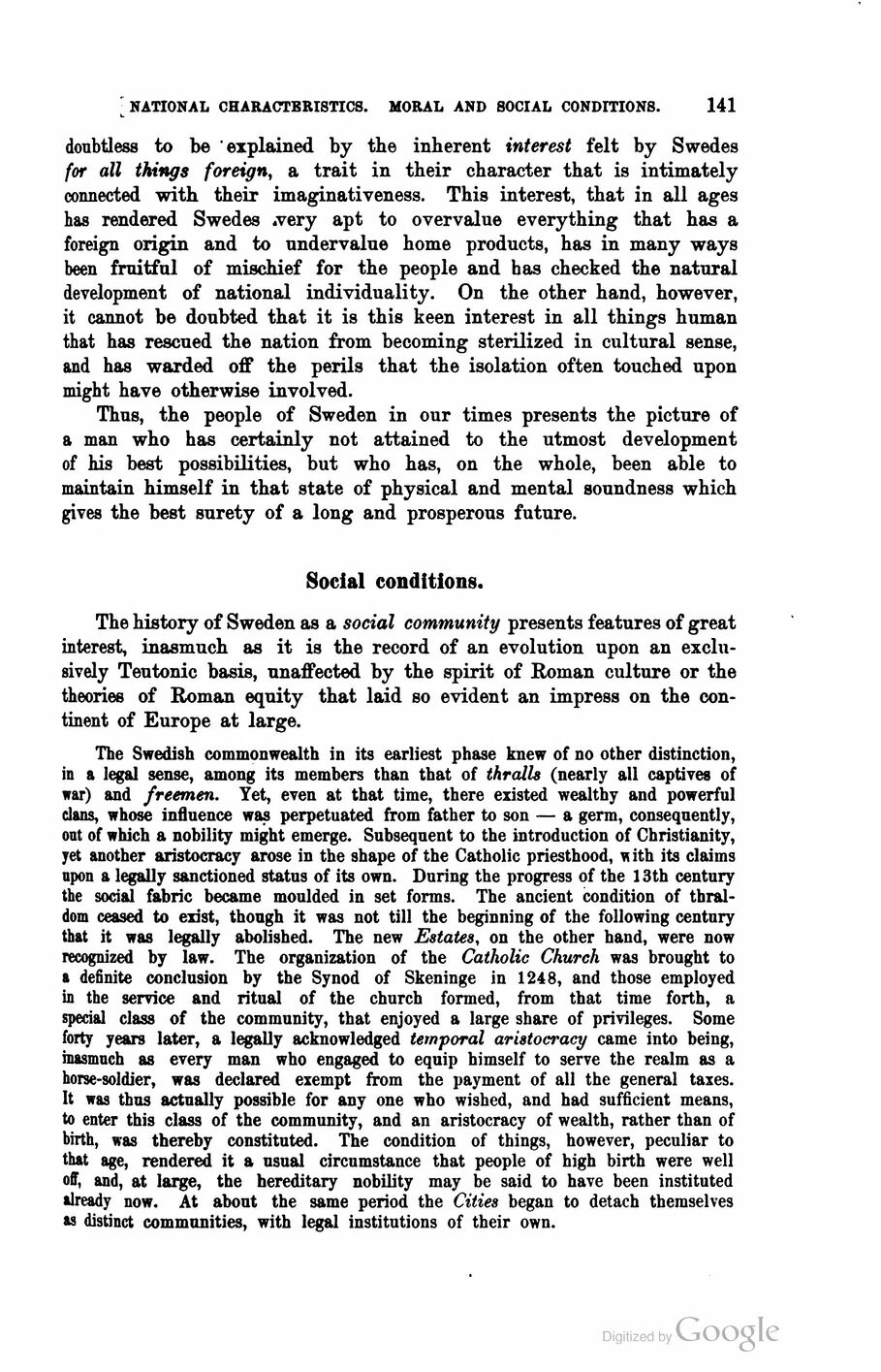
Full resolution (JPEG) - On this page / på denna sida - First part - II. The Swedish People - 3. National Characteristics. Moral and Social Conditions - National Characteristics - Social Conditions, by Theophil Andersson, Ph. D., Actuary at the Board of Trade, Stockholm

<< prev. page << föreg. sida << >> nästa sida >> next page >>
Below is the raw OCR text
from the above scanned image.
Do you see an error? Proofread the page now!
Här nedan syns maskintolkade texten från faksimilbilden ovan.
Ser du något fel? Korrekturläs sidan nu!
This page has never been proofread. / Denna sida har aldrig korrekturlästs.
NATIONAL CHARACTERISTICS. MORAL AND SOCIAL CONDITIONS. 141
doubtless to be explained by the inherent interest felt by Swedes
for all things foreign, a trait in their character that is intimately
connected with their imaginativeness. This interest, that in all ages
has rendered Swedes .very apt to overvalue everything that has a
foreign origin and to undervalue home products, has in many ways
been fruitful of mischief for the people and has checked the natural
development of national individuality. On the other hand, however,
it cannot be doubted that it is this keen interest in all things human
that has rescued the nation from becoming sterilized in cultural sense,
and has warded off the perils that the isolation often touched upon
might have otherwise involved.
Thus, the people of Sweden in our times presents the picture of
a man who has certainly not attained to the utmost development
of his best possibilities, but who has, on the whole, been able to
maintain himself in that state of physical and mental soundness which
gives the best surety of a long and prosperous future.
Social conditions.
The history of Sweden as a social community presents features of great
interest, inasmuch as it is the record of an evolution upon an
exclusively Teutonic basis, unaffected by the spirit of Boman culture or the
theories of Roman equity that laid so evident an impress on the
continent of Europe at large.
The Swedish commonwealth in its earliest phase knew of no other distinction,
in a legal sense, among its members than that of thralls (nearly all captives of
war) and freemen. Yet, even at that time, there existed wealthy and powerful
dans, whose influence was perpetuated from father to son — a germ, consequently,
out of which a nobility might emerge. Subsequent to the introduction of Christianity,
yet another aristocracy arose in the shape of the Catholic priesthood, with its claims
upon a legally sanctioned status of its own. During the progress of the 13th century
the social fabric became moulded in set forms. The ancient condition of
thraldom ceased to exist, though it was not till the beginning of the following century
that it was legally abolished. The new Estates, on the other hand, were now
recognized by law. The organization of the Catholic Church was brought to
a definite conclusion by the Synod of Skeninge in 1248, and those employed
in the service and ritual of the church formed, from that time forth, a
special class of the community, that enjoyed a large share of privileges. Some
forty years later, a legally acknowledged temporal aristocracy came into being,
inasmuch as every man who engaged to equip himself to serve the realm as a
horse-soldier, was declared exempt from the payment of all the general taxes.
It was thus actually possible for any one who wished, and had sufficient means,
to enter this class of the community, and an aristocracy of wealth, rather than of
birth, was thereby constituted. The condition of things, however, peculiar to
that age, rendered it a usual circumstance that people of high birth were well
off, and, at large, the hereditary nobility may be said to have been instituted
already now. At about the same period the Cities began to detach themselves
»s distinct communities, with legal institutions of their own.
<< prev. page << föreg. sida << >> nästa sida >> next page >>